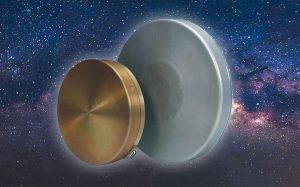What is a Reaction Wheel in Satellite Systems?
A reaction wheel is a key device used in satellite attitude control systems. It helps manage the orientation of a satellite in space by utilizing the conservation of angular momentum. By spinning at variable speeds, the reaction wheel applies torque to the satellite, causing it to rotate in the opposite direction.
Reaction wheels are used to precisely control the satellite’s orientation along its pitch, yaw, and roll axes. Unlike traditional thrusters, they do not rely on fuel, making them ideal for long-term missions, including Earth observation, scientific research, and deep space exploration.

How Does a Reaction Wheel Work?
1. Angular Momentum and Torque Generation
The principle behind a reaction wheel’s operation is angular momentum. When the wheel accelerates or decelerates, the satellite reacts by rotating in the opposite direction to conserve momentum. The torque generated by the wheel is proportional to the rate of change in the wheel’s speed.
In practical terms, by adjusting the wheel’s rotation, satellite engineers can achieve precise orientation control. This is crucial for tasks like pointing instruments at specific targets or stabilizing communications antennas.
2. Wheel Speed Control
By controlling the wheel’s speed, satellites can adjust their orientation with great accuracy. For example, to rotate a satellite, the onboard control system will spin the wheel in one direction, causing the satellite to rotate in the opposite direction. This allows for continuous and smooth attitude control without requiring large amounts of fuel or external propulsion.
Advantages of Using Reaction Wheels in Satellites
1. Fuel-Free Operation
Unlike traditional thrusters, which require fuel to produce thrust, reaction wheels are powered by electrical energy and do not use any propellant. This feature makes them highly suitable for long-duration missions, as they do not rely on limited resources like fuel, which is critical for deep space missions.
2. High Precision Control
Reaction wheels provide precise and fine-tuned control over a satellite’s orientation. This accuracy is necessary for missions that require high pointing precision, such as space telescopes, Earth observation satellites, and communication platforms.
3. Reliability and Longevity
With fewer moving parts compared to other attitude control mechanisms, reaction wheels are generally reliable and have a long operational lifespan. The absence of chemical propellants also reduces the risk of system failure, making them a trusted choice for space agencies.
Challenges in Reaction Wheel Systems
1. Saturation and Wheel Failure
One of the primary challenges of reaction wheels is saturation. When a wheel reaches its maximum rotational speed, it cannot provide further torque. This limits the satellite’s ability to adjust its orientation, especially when the mission requires continuous control. To overcome this, multiple reaction wheels or additional systems like magnetorquers are often used for redundancy.
2. Energy Consumption
While reaction wheels don’t use fuel, they still require electrical power to operate. The spinning of the wheel consumes energy, which can be a limitation, especially for smaller satellites with limited power resources. Efficient energy management and solar panel support are essential to ensure smooth operations.
3. Wear and Tear Over Time
As reaction wheels continue to operate, they experience wear, which can lead to performance degradation. Engineers must account for this in long-term missions and often design systems with multiple wheels to balance the load and prevent early failure.
Applications of Reaction Wheels in Satellites
1. Earth Observation Satellites
Satellites designed for Earth observation require precise pointing to capture high-resolution images of the Earth’s surface. Reaction wheels provide the necessary attitude control to stabilize cameras and sensors, ensuring accurate data collection.
2. Space Telescopes and Research Satellites
Space telescopes like Hubble and research satellites rely heavily on reaction wheels to maintain their orientation while observing distant objects in space. The high precision of reaction wheels allows these instruments to remain stable and accurately focused on specific targets.
3. Communication Satellites
Communication satellites need to maintain a stable orientation to ensure continuous and reliable signal transmission. Reaction wheels enable these satellites to stay aligned with ground stations or other communication satellites.
The Future of Reaction Wheel Technology
1. Miniaturization for Small Satellites
As small satellites (CubeSats, for example) continue to grow in popularity, the demand for miniaturized reaction wheels is increasing. Smaller, lighter reaction wheels will be essential for providing attitude control in compact, low-cost satellites used for scientific, commercial, and military purposes.
2. Hybrid Systems for Enhanced Performance
Future satellite systems may combine reaction wheels with other attitude control methods, such as control moment gyroscopes or magnetorquers. This hybrid approach could provide better performance, redundancy, and more flexibility in controlling satellite orientation, especially in challenging environments.
Want to learn more about satellite attitude control systems and how they improve mission success?
Click here for in-depth insights into the technologies driving spacecraft stability and performance.
